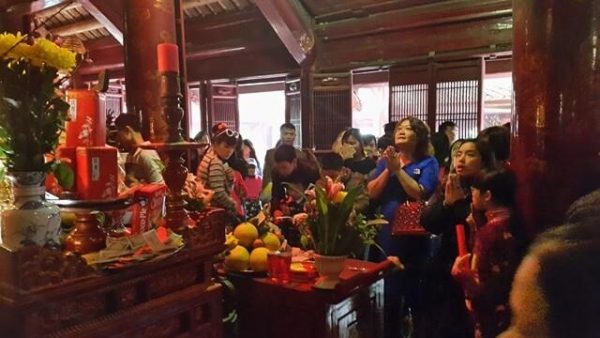As the first university relic complex in our country, the Temple of Literature is not only a cultural and historical relic but also a place where many scholars and students come here to pray for luck in exams and study. . Here, Vntrip.vn will introduce and share the most complete experience of going to the Temple of Literature – Quoc Tu Giam for your reference as well as convenient to visit this famous monument in Hanoi.
Where is Van Mieu Quoc Tu Giam?
- Address: 58 Quoc Tu Giam, Dong Da, Hanoi
- Directions to Temple of Literature
Temple of Literature is located in Dong Da district, Hanoi, right in the middle of 4 main streets including Nguyen Thai Hoc, Ton Duc Thang, Temple of Literature and Quoc Tu Giam. Traveling to Hanoi with thousands of years of civilization, this is definitely a place that you should visit.
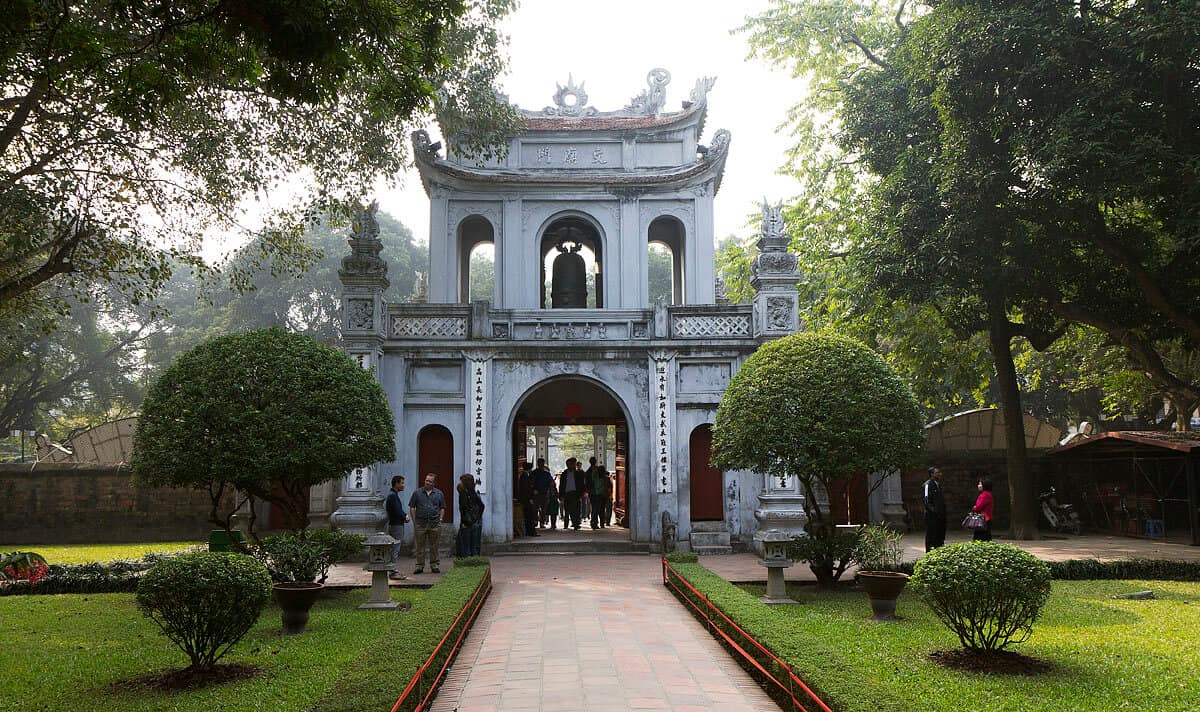
Pictures of Temple of Literature (photo collection)
If starting from Hoan Kiem Lake, you follow Le Thai To street, turn right onto Trang Thi street, go towards Cua Nam and Nguyen Khuyen streets, then turn left onto Van Mieu street. Because Hanoi road has many one-way streets, especially around the Temple of Literature, you should pay attention to avoid breaking traffic laws.
If you go by bus, if you take the following lines, there will be stops near this area: 02, 23, 38, 25, 41.
Entrance ticket price
Currently, tourists and people entering the Temple of Literature must buy entrance tickets. Tickets for adults are 20,000 VND and children’s tickets are 10,000 VND. This is a fairly cheap price and applies to both Vietnamese and foreign guests.
History of Temple of Literature
The Temple of Literature was built in 1070 under the reign of King Ly Thanh Tong, and is a place to worship Confucius, Chu Cong and Tu Mai. In 1076, King Ly Nhan Tong established Quoc Tu Giam next to a university dedicated to the king’s children and noble families. In the reign of King Tran Thai Tong, Quoc Tu Giam was renamed Quoc Academy and accepted the children of ordinary people with excellent academic ability.
In the post-Le era, the reign of King Le Thanh Tong began to erect steles of those who passed the doctorate exam. By the Nguyen Dynasty, Quoc Tu Giam was established in Hue. The Temple of Literature of Thang Long was remodeled to only be the Temple of Literature of Bac Thanh town, later changed to the Temple of Literature in Hanoi.
Architecture
The Van Mieu – Quoc Tu Giam relic complex is currently located in an area of 54331 m2, including many different small architectural works. Surrounding the campus are brick walls. After many renovations, this relic complex includes Ho Van, Temple of Literature, Dai Trung Mon, Khue Van Cac, Thien Quang well, Doctor’s stele, Dai Thanh Mon, Thai Hoc house.
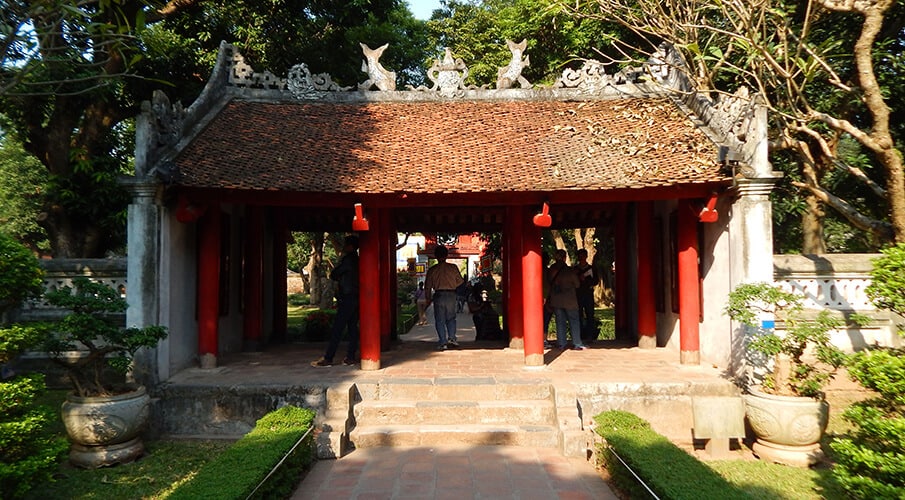
Dai Trung Mon (photo collection)
The teaching house is on the east and west sides, two rows of 14 compartments. The classrooms of the three students are in three rows, each row has 25 compartments, each room has 2 people. The entire current architecture of the Temple of Literature is the architecture of the early Nguyen Dynasty. The architectural complex of Van Mieu – Quoc Tu Giam is arranged for each zone, each layer according to the North-South axis, simulating the overall planning of the Temple of Literature worshiping Confucius in China, however, the scale here is simple. and in the traditional way of national art.
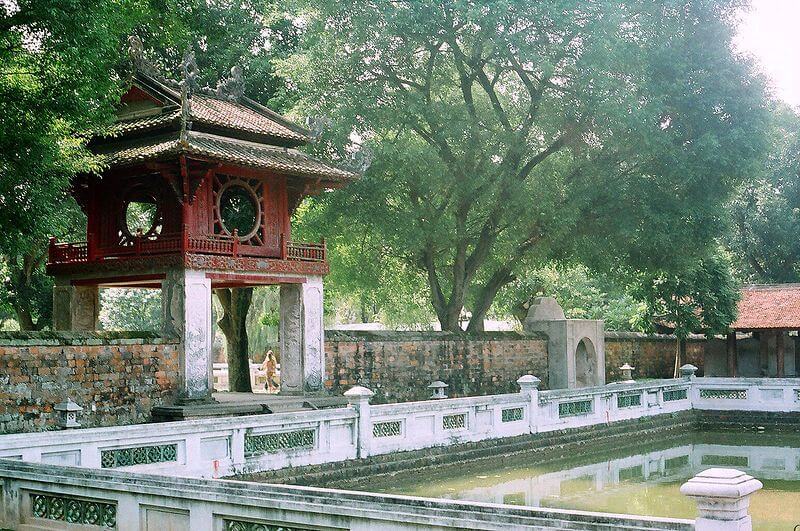
Khue Van Cac and Thien Quang well (collected photos)
In front of the Temple of Literature, there is a large lake called Van Chuong lake, the old name was called Thai Ho. In the middle of the lake, there is Kim Chau mound, formerly there is a floor for sightseeing. In addition to the main gate, there are four pillars, on the left and right sides there is a stele “Ha Ma”, around the high-walled area. The Temple of Literature Gate was built in Tam Quan style, with 3 words “Temple of Literature” on it in ancient Chinese characters. In the Temple of Literature, it is divided into 5 distinct areas, each area has a separating wall and a connecting gate.
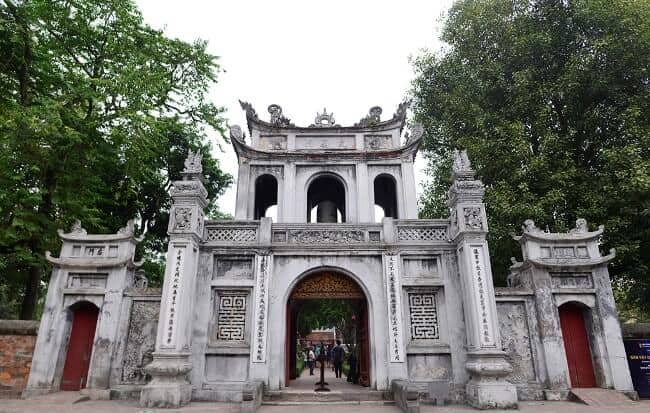
Temple of Literature (collected photos)
Attractions in the Temple of Literature
The main gate of the Temple of Literature is built in the style of Tam Quan, with 3 words “Temple of Literature” in ancient Chinese characters. The Temple of Literature is surrounded by brick walls. Inside there are also walls dividing into 5 zones, each area has a separating wall and a gate.

Map to visit Van Mieu Quoc Tu Giam relic site
The first zone
Starting with the main gate of Van Mieu Mon, go to Dai Trung Mon gate, two small doors are Thanh Duc Mon and Dat Tai Mon.
Second zone
From Dai Trung Mon to Khue Van Cac. Khue Van Cac is an architectural work that, although not massive, has a harmonious and beautiful proportions. The architecture consists of 4 square brick pillars (85cm x 85cm) below supporting the upper floor, with beautiful wooden structures.
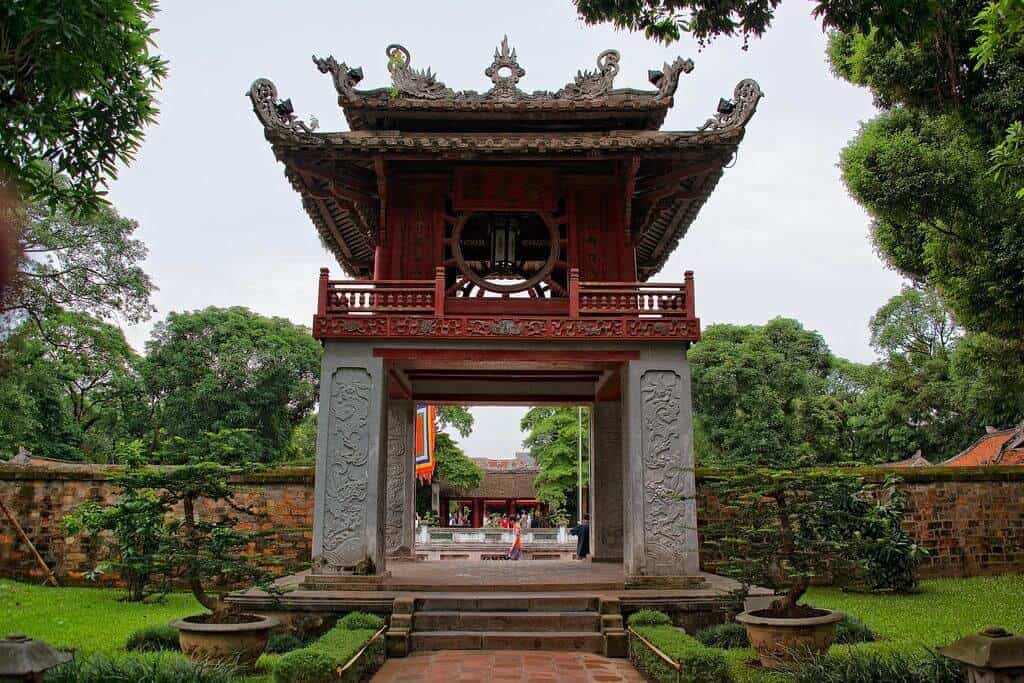
Khue Van Cac (photo collection)
The upper floor has 4 round doors, a row of handrails and a simple, rustic wooden roof support. The roof tile overlaps two layers to form a work of 8 roofs, roof ledge and flat roof surface.
The attic is a square floor with eight roofs, four sides of the attic wall are round windows in the shape of the sun radiating rays of light. To the right and left of Khue Van Cac are Bi Van Mon and Suc Van Mon leading to two areas of Doctor’s stele house.
Khue Van Cac at the Temple of Literature – Quoc Tu Giam has been recognized as a symbol of Hanoi city.
Third zone
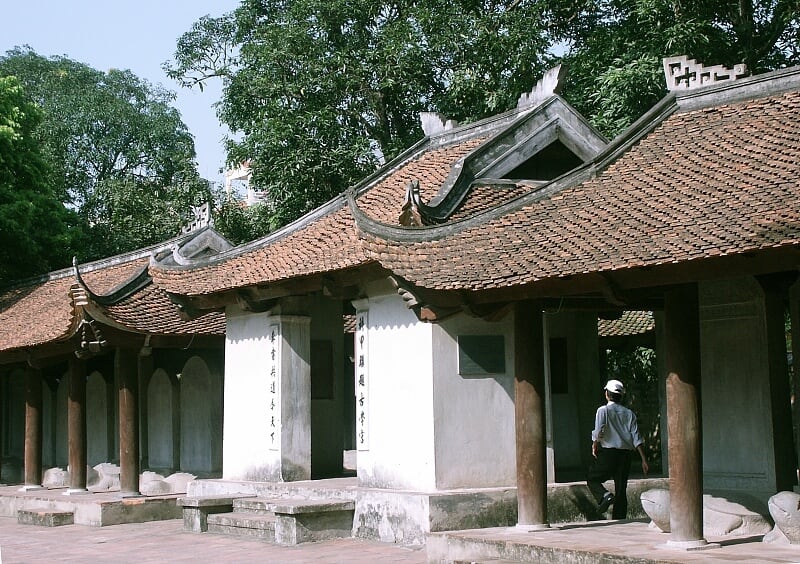
Doctor’s beer house (collected photos)
Including Thien Quang Tinh lake (meaning sun well), square shape. The two sides of the lake are the stele house of Dr. Each stele is made of stone, engraved with the names of the poinsettias, Ban Longan, Tham Hoa, Hoang Giap, and Dr. The beer is placed on the back of the stone turtle. There are still 82 steles of the examinations from 1442 to 1779. These are the most precious relics of the relic.
Fourth zone
It is the central area and the main architecture of the Temple of Literature, consisting of two large works arranged in parallel and in succession. The outer building is Bai Duong, the inner building is the Upper Palace. This is the area to worship Confucius and Tu Phoi (Nhan Tu, Tang Tu, Tu Tu, and Mencius).
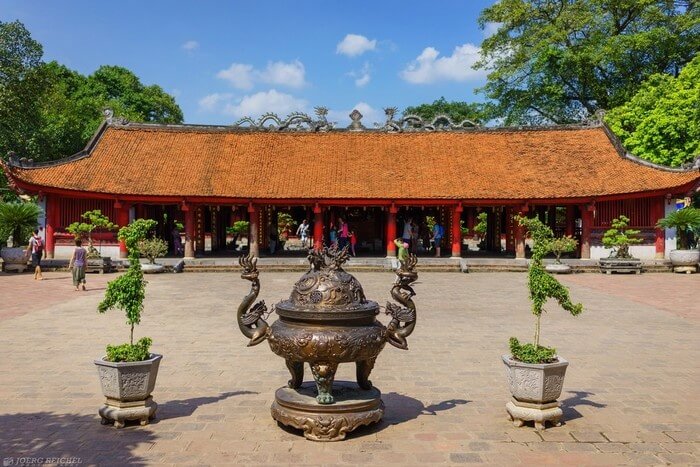
Temple of Literature at Temple of Literature (collected photos)
Fifth zone
This is Thai Hoc house. Under the Nguyen Dynasty, the Quoc Tu Giam School in Hanoi was abolished, the ethnographer was changed to the Khai Thanh house, worshiping the father and mother of Confucius. However, this building was destroyed during the resistance war against the French. The new Thai Hoc house was rebuilt by Hanoi city in 1999. In this fifth area, there is also the front house – the post house, which is the place to worship Kings Ly Thanh Tong, Ly Nhan Tong, Le Thanh Tong and the private sector. Quoc Tu Giam Chu Van An.
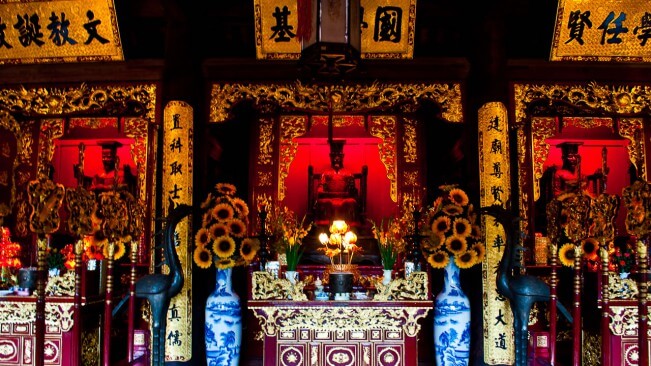
Altar of 3 kings in Van Mieu Quoc Tu Giam (collected photos)
Meaning of Temple of Literature
Temple of Literature – Quoc Tu Giam is not only the first university of our country but also like a burning candle, lighting up the studious tradition of the Vietnamese people. Coming here, you seem to be motivated by the brilliant gold panels of your forefathers, loaded with full of energy to be confident in your journey of learning and discovering human knowledge.
In addition, today, the Temple of Literature – Quoc Tu Giam is also a place to organize poetry festivals, a place to commend outstanding and outstanding students, and a famous sightseeing place attracting a large number of domestic and international tourists. economy when coming to Hanoi. At the same time, this is also the meeting place to “ask for words” of the people of the capital during the traditional New Year holidays with the wish of a peaceful new year; or in the important exam seasons of the country with the belief of passing the “soldiers”.
Note when visiting
- Respect the relic and abide by the regulations of the relic management unit. Do not infringe on artifacts, landscape monuments. Do not rub the turtle’s head, write, draw, stand, or sit on the stele of Dr.
- Costumes when coming to the Temple of Literature should be clean and neat. Do not wear skirts or pants that are too short, revealing clothing or indoor clothing. Do not smoke, wear hats, hats in the area of the Temple, the gallery…
- Carrying out a civilized lifestyle in places of worship: No acts of unethicality, profanity, or disturbance of security; Having the right attitude when performing the ceremony, each person only lights one stick of incense; Offer offerings and burn incense at the designated places.
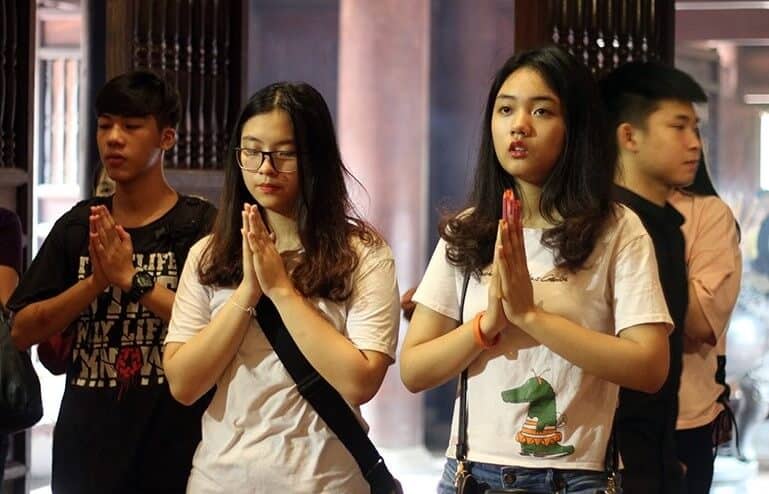
Incense offering in the Temple of Literature (photo collection)
- It is strictly forbidden to take advantage of the right to freedom of belief to carry out superstitious activities, gambling, fraud, etc.
- Maintain hygiene and protect the environment: Do not climb walls, climb trees, break branches, pick flowers, step on grass, fish, swim, or throw garbage indiscriminately.
- Do not bring weapons, explosives or flammable substances into the relic.
- Leave the car in the right place, manage your personal belongings to avoid loss.
- Filming activities at Van Mieu Quoc Tu Giam can only be done with the consent of the leader of the relic site.
Through many ups and downs of time and historical events, some of the architectures here have been destroyed, but the Temple of Literature – Quoc Tu Giam is still considered a symbol of the educational quintessence and cultural beauty of Vietnam. Ethnic Vietnam. Hopefully, the sharing of Vntrip.vn above has helped you gain more knowledge about this meaningful historical – cultural relic of the capital.
Source: Collected internet.
